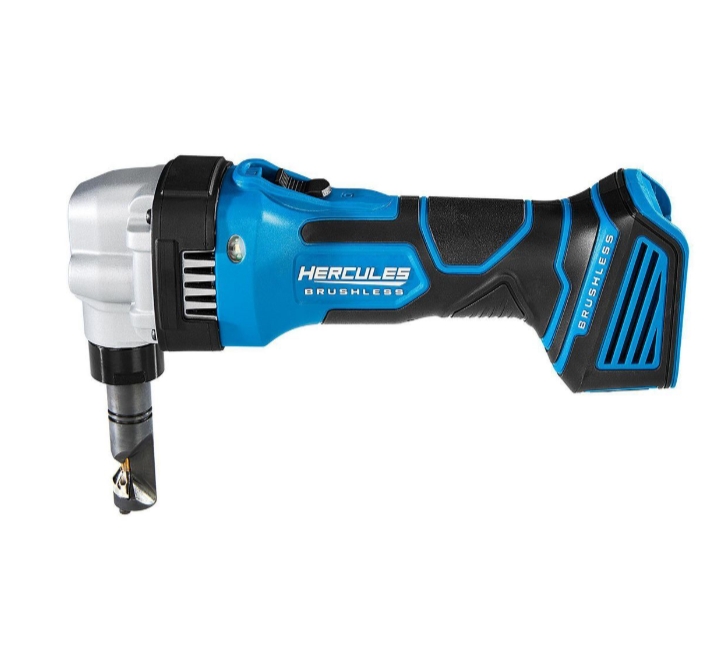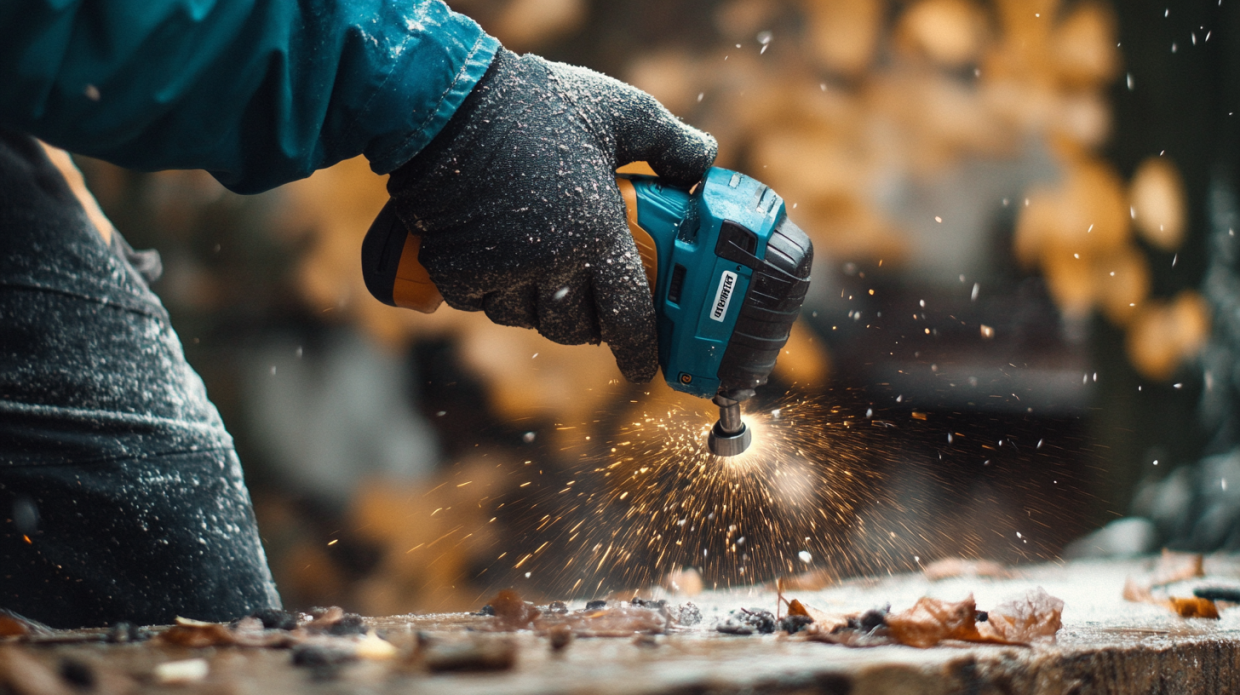
HERCULES 20V Brushless Cordless 16 Gauge Nibbler – Tool Only
- The professional HERCULES™ 20V Lithium-Ion Brushless Cordless 16 Gauge Nibbler is engineered with a powerful brushless motor that delivers up to 2200 SPM for quick, clean, tight cuts in a variety of metals. This nibbler cuts up to 118 ft. per charge* with the powerful HERCULES™ Battery System. It has a 2 in. minimum outer-edge cutting radius for making clean profiles.
- Ideal for cutting 16 gauge sheet metal, 18 gauge stainless steel, corrugated steel, and roofing panels
- Die holder rotates 360° to meet the demands of cutting direction
- Onboard sheet metal thickness gauge
- Easy-to-read kerf guide for following cut line
- Rubberized non-skid pad keeps nibbler from sliding when not in use
- Slide switch provides lock-on function to reduce fatigue during long cutting periods
- Rubberized soft grip for improved comfort
$119.99
After fifteen years in metal fabrication, I’ve handled nearly every cutting tool on the market. But when I discovered the Hercules Nibbler, everything changed. From professional projects to weekend DIY adventures, this versatile tool has become indispensable in my workshop. In this guide, I’ll share everything I’ve learned about what might be the most underrated power tool in metalworking.
What Exactly Is a Hercules Nibbler?
The first time I saw a Hercules Nibbler in action at my buddy’s auto body shop, I was genuinely impressed. Unlike traditional cutting tools that rely on blades or abrasive discs, the nibbler uses a punching action to “nibble” away small bits of material with each stroke. The genius lies in its design—a rapidly reciprocating punch that moves up and down through a die, removing tiny bits of metal with each cycle.
The Hercules Nibbler specifically refers to a heavy-duty nibbler produced by Hercules Tools, though many metalworkers (myself included) sometimes use the term generically for similar tools in the category. What sets the Hercules apart is its robust construction and powerful motor that can handle professional-grade applications while remaining accessible to serious DIYers.
I remember my first project with it—customizing some sheet metal panels for a vintage motorcycle restoration. The clean, burr-free cuts and ability to create intricate shapes sold me immediately. Unlike circular saws that can warp thin metal or plasma cutters that require significant setup, the nibbler offered precision with minimal fuss.
The Hercules Nibbler vs. Other Metal-Cutting Tools
Before investing in my Hercules Nibbler, I used various cutting tools with mixed results. Let me break down how it compares to other options I’ve used extensively:
Nibbler vs. Sheet Metal Shears
Traditional electric shears were my go-to for years. They cut with scissor-like blades and work well for straight lines, but they have limitations:
- Shears struggle with tight curves and interior cutouts
- They often leave distorted edges that require finishing
- The cutting capacity is typically limited to thinner gauges
The Hercules Nibbler, by contrast, excels at curve-cutting and creates interior cutouts with just a small drill hole to start. The edges come out cleaner, though they do have a slightly serrated texture from the nibbling action (nothing a quick file pass can’t fix).
Nibbler vs. Plasma Cutter
My plasma cutter is fantastic for thick materials, but for everyday sheet metal work, it’s overkill:
- Plasma requires significant setup and safety equipment
- It creates a heat-affected zone that can warp thin materials
- The consumable costs add up quickly
- It requires a power source and often compressed air
The Hercules Nibbler produces no heat, requires minimal setup, and costs significantly less to operate. For sheet metal under 14-gauge, I consistently reach for the nibbler first.
Nibbler vs. Aviation Snips
Manual aviation snips are affordable and simple but limited:
- They cause hand fatigue during extended use
- Their cutting capacity is very limited
- Creating precise curves requires significant skill
The power-driven Hercules Nibbler eliminates hand fatigue and maintains consistent cutting quality regardless of the operator’s strength or endurance. After a full day of cutting with the nibbler, my hands thank me.
Material Capabilities: What Can the Hercules Nibbler Handle?
In my experience, the Hercules Nibbler truly shines when cutting:
Sheet Metal
This is where the Hercules Nibbler excels. I’ve used it on everything from 24-gauge decorative sheets to 14-gauge structural panels. The clean cuts and minimal distortion make it perfect for visible pieces or components that need to maintain their dimensions.
The first time I used it to cut custom air intake vents for a restoration project, I was amazed at how precisely I could follow my traced lines. The resulting pieces required almost no finishing work.
Stainless Steel
I was initially skeptical about the Hercules Nibbler’s performance on stainless, as it’s notoriously tough on cutting tools. To my surprise, it handled 18-gauge stainless steel sheets without complaint, though I did notice slightly faster wear on the punch and die components.
When renovating my kitchen with custom stainless steel backsplashes, the nibbler made quick work of outlet cutouts and corner details that would have been challenging with other tools.
Aluminum
The Hercules Nibbler cuts through aluminum like butter. I’ve used it on everything from thin 0.040″ decorative panels to 1/8″ structural components. The clean, burr-free cuts make it ideal for visible architectural elements.
My garage storage system features custom aluminum panels cut entirely with the nibbler, including ventilation patterns that would have been impossible with traditional shears.
Copper and Brass
For ornamental metalwork, the nibbler’s ability to cut decorative patterns in softer metals like copper and brass is invaluable. I’ve created custom light fixtures and decorative elements with intricate cutouts that garner compliments whenever guests visit.
Corrugated and Ribbed Materials
This is where the nibbler truly separates itself from scissors-type cutters. The punch-and-die mechanism easily handles corrugated metal roofing, ribbed panels, and other non-flat materials that would bind or jam traditional shears.
When I replaced sections of damaged metal roofing on my workshop, the nibbler cut replacement pieces that perfectly matched the original profile—something impossible with most other cutting methods.
Materials to Avoid
Through trial and error, I’ve learned the Hercules Nibbler isn’t suitable for:
- Hardened steel (like tool steel)
- Materials thicker than the specified maximum capacity
- Extremely soft materials like rubber or plastic (they tend to tear rather than cut cleanly)
- Wood or composite materials (they’ll quickly dull the cutting components)
Professional Workshop or Weekend Warrior: Is the Hercules Nibbler Right for You?
One question I frequently get from fellow metalworkers is whether the Hercules Nibbler is suitable for professional use or better suited to hobbyists. After using mine in both capacities, I can confidently say: it’s built for both.
Professional Applications
In professional settings, I’ve found the Hercules Nibbler invaluable for:
- HVAC ductwork fabrication
- Metal roofing installation and repair
- Custom auto body work
- Stainless steel kitchen equipment manufacturing
- Architectural metal details
- Electrical panel modifications
The tool’s durability stands up to daily use, and the consistent cutting quality ensures professional results. One HVAC contractor I know maintains a fleet of three nibblers to keep his team productive.
DIY and Hobbyist Use
For home projects and hobbyists, the Hercules Nibbler offers:
- Accessibility for metal projects without industrial equipment
- Clean cuts without distortion for visible projects
- The ability to work on projects in tight spaces
- Lower noise levels than many cutting alternatives
- Minimal setup and cleanup compared to other methods
My neighbor borrowed my nibbler for a weekend project cutting custom metal planters, and he immediately ordered his own after experiencing how much easier it made the work.
Where to Buy and What to Expect on Price
When I decided to purchase my Hercules Nibbler, I researched extensively. Here’s what I discovered:
Purchasing Options
The Hercules Nibbler is available through several channels:
- Specialty Tool Retailers: Stores like Harbor Freight carry the Hercules line, offering the advantage of seeing the tool in person before purchasing.
- Online Marketplaces: Amazon, eBay, and other online platforms often carry the Hercules Nibbler, sometimes at competitive prices.
- Industrial Supply Companies: McMaster-Carr, Grainger, and similar suppliers stock professional-grade nibblers, including the Hercules model.
- Direct from Manufacturer: Depending on your location, purchasing directly from Hercules Tools may be an option.
Price Range and Value Proposition
The Hercules Nibbler typically ranges from $89 to $189, depending on the specific model, included accessories, and where you purchase it. This places it in the mid-range for metal cutting tools—more expensive than basic aviation snips but significantly less costly than plasma cutters or industrial shears.
After using mine for three years, I consider it one of the best value-for-money tools in my collection. The initial investment has paid for itself many times over in time saved and the ability to take on projects I couldn’t otherwise accomplish.
Package Options
The basic Hercules Nibbler typically includes:
- The nibbler tool itself
- A standard punch and die set installed
- Basic operating instructions
- Storage case (on some models)
I recommend looking for packages that include additional punch and die sets, as these are wear items that will eventually need replacement.
Key Features That Set the Hercules Nibbler Apart
What makes the Hercules Nibbler worth considering over other brands? After comparing with several other nibblers, these features stand out:
Robust Motor and Gearing
The 5-amp motor in my Hercules Nibbler provides consistent power even when cutting through thicker materials. Unlike some budget models that bog down, the Hercules maintains its cutting speed through demanding applications.
Ergonomic Design
The balanced weight distribution and comfortable grip reduce fatigue during extended use. The trigger lock feature has saved my hand on longer cuts, allowing continuous operation without constantly squeezing the trigger.
Swivel Head Design
Perhaps my favorite feature is the 360-degree swivel head that allows cutting in any direction without awkward wrist positions. When working on complex shapes or in tight spaces, this feature is invaluable.
Quick-Change Punch and Die System
Replacing worn cutting components or switching to different sizes takes less than a minute with the tool-free replacement system. This design has saved me considerable downtime compared to older nibbler models.
Dust Collection Port
The integrated dust collection port can connect to a shop vacuum, dramatically reducing the tiny metal chips that would otherwise scatter everywhere. This feature alone has saved me hours of cleanup time.
Cutting Capacity: How Much Can the Hercules Nibbler Handle?
Understanding the Hercules Nibbler’s limitations is critical to avoid damaging the tool or producing poor results. Based on my experience, these are the reliable capacities:
Mild Steel
- 16-gauge (0.0598″): Cuts easily at full speed
- 14-gauge (0.0747″): Cuts well with moderate feed rate
- 12-gauge (0.1046″): Near maximum capacity, requires slow, careful operation
Stainless Steel
- 18-gauge (0.0478″): Cuts smoothly
- 16-gauge (0.0598″): Approaching maximum capacity for stainless
Aluminum
- 1/8″ (0.125″): Cuts easily
- 3/16″ (0.1875″): Maximum capacity, requires patience
Copper and Brass
- 16-gauge (0.0508″): Effortless cutting
- 14-gauge (0.0641″): Maximum recommended thickness
In practice, I’ve found the Hercules Nibbler performs best when used at about 75% of its maximum capacity. This extends the life of the cutting components and produces cleaner cuts.
Real-World Performance on Sheet Metal
The technical specifications tell one story, but real-world performance is what matters in the workshop. Here’s how the Hercules Nibbler has performed for me across various sheet metal applications:
Straight Cuts
The nibbler excels at straight cuts, especially when guided along a straight edge. The cutting action leaves a narrow kerf (approximately 1/8″) with minimal burring. I’ve cut 10-foot lengths of galvanized steel for rain gutters with perfectly straight results.
Curved Cuts and Profiles
This is where the Hercules Nibbler truly outshines other cutting methods. The ability to change direction instantly without binding makes it perfect for following complex patterns. When I needed to cut custom ventilation grilles with an ornate pattern, the nibbler followed my template perfectly.
Inside Cutouts
For interior cutouts, simply drill a starter hole slightly larger than the die diameter, insert the tool, and begin cutting. I’ve created electrical panel cutouts, HVAC register openings, and decorative patterns with clean edges and perfect dimensions.
Edge Quality
The nibbling action creates a slightly serrated edge with minimal burring. For most applications, this edge quality is acceptable without further finishing. When absolutely smooth edges are required, a quick pass with a file or deburring tool is all that’s needed.
Cutting Speed
On 18-gauge mild steel, I can cut approximately 3-4 feet per minute with the Hercules Nibbler. Thicker materials or tighter curves naturally slow the process, but it remains significantly faster than hand snips and more precise than many powered alternatives.
Warranty Coverage and Support
The warranty on the Hercules Nibbler typically provides:
- 90-day to 2-year coverage on the tool itself (depending on the model)
- 30-day warranty on wear components (punch and die)
- Protection against manufacturing defects
- Options for repair or replacement
I recommend registering your tool immediately after purchase and keeping all documentation. When I had an issue with my trigger mechanism after a year of heavy use, the warranty process was straightforward, and I had a repaired tool back in my hands within two weeks.
What Users Are Saying: Hercules Nibbler Reviews
To provide a balanced perspective, I’ve compiled feedback from my own experience and those of colleagues and online reviewers:
Positive Feedback
- “Transformed my metal fabrication process—cuts that would take an hour with snips now take minutes.”
- “Perfect for automotive body work where heat distortion from other cutting methods would be problematic.”
- “The swivel head feature makes it possible to cut in any direction without awkward positioning.”
- “Remarkably clean cuts on stainless steel without the mess of abrasive methods.”
Critical Feedback
- “Replacement punch and die sets can be expensive if you’re cutting harder materials regularly.”
- “Louder than expected—hearing protection recommended for extended use.”
- “The weight becomes noticeable during overhead cutting tasks.”
- “The 1/8″ minimum turning radius means very tight inside corners require finishing with other tools.”
In my experience, the positive aspects far outweigh the limitations, particularly if you understand what the tool is designed to do and don’t try to push beyond its capabilities.
Power Options: Corded vs. Cordless Models
The Hercules Nibbler is available in both corded and cordless configurations:
Corded Hercules Nibbler
The standard corded model (which I use most frequently) offers:
- Consistent power regardless of runtime
- No battery limitations
- Slightly lighter weight
- Lower initial cost
The 10-foot cord provides decent mobility, though I’ve added an extension cord for larger projects.
Cordless Hercules Nibbler
The battery-powered version provides:
- Complete mobility without cords
- Similar cutting capacity to the corded model
- Typically includes two batteries for continuous operation
- Higher initial investment
For contractors moving between job sites or working in areas without reliable power, the cordless version makes sense. For my workshop-based projects, the corded model provides better value.
Nibbler vs. Shear Cutter: Understanding the Difference
I often hear confusion between nibblers and shear cutters, so let me clarify the differences:
How Nibblers Work
The Hercules Nibbler uses a punch-and-die mechanism that removes small bits of material with each stroke—typically 3,000 to 4,000 strokes per minute. This creates a narrow cutting path (about 1/8″ wide) where material is actually removed.
How Shear Cutters Work
Electric shears use opposing blades in a scissor-like action to slice through material. No material is removed; instead, the metal is separated along the cutting line.
Key Differences
- Cutting Path: Nibblers remove material, creating a kerf; shears simply separate material
- Waste Production: Nibblers produce small metal chips; shears produce no waste except at the beginning of the cut
- Cutting Capabilities: Nibblers excel at curves and interior cutouts; shears perform best on straight or gently curved lines
- Material Distortion: Nibblers cause minimal distortion; shears can cause some bending or warping
- Thickness Capacity: Professional-grade versions of both can handle similar thicknesses, though nibblers typically have a slight advantage on thicker materials
For my work, I actually maintain both tools—the shear for long straight cuts where material conservation is important, and the nibbler for everything else.
Ease of Use: Learning Curve and Techniques
One of the Hercules Nibbler’s greatest strengths is its accessibility. Unlike plasma cutting or even some power shears, the learning curve is remarkably short.
Getting Started
The first time I used the Hercules Nibbler, I was making decent cuts within minutes. The basic operation is straightforward:
- Mark your cutting line
- Position the tool with the die beneath the material
- Squeeze the trigger and begin moving along your line
- Maintain a steady pace to ensure clean cuts
Advanced Techniques
Over time, I’ve developed techniques that maximize the nibbler’s effectiveness:
- Using Guide Strips: Clamping a straight edge as a guide ensures perfectly straight cuts
- Template Following: Creating hardboard templates for repeated patterns improves consistency
- Direction Changes: Slowing down slightly before changing direction produces cleaner corners
- Optimizing Feed Rate: Listening to the motor tells you when you’re pushing too fast or too slow
- Managing Chips: Positioning the work to direct chips away from the cutting line improves visibility
The most important skill is developing a feel for the appropriate feed rate. Too slow, and you waste time; too fast, and you risk jamming or producing rough cuts.
Power and Performance Specifications
The Hercules Nibbler’s performance comes from its well-engineered power system:
- Motor Rating: 5 amps (corded model)
- No-Load Speed: 2,200 RPM
- Stroke Rate: 3,500 strokes per minute
- Maximum Capacity (mild steel): 14-gauge (0.0747″)
- Maximum Capacity (stainless steel): 16-gauge (0.0598″)
- Maximum Capacity (aluminum): 1/8″ (0.125″)
- Minimum Cutting Radius: 1/8″
- Typical Cutting Width: 0.197″ (5mm)
- Tool Weight: 4.2 lbs (corded), 5.1 lbs (cordless with battery)
These specifications place the Hercules Nibbler firmly in the professional-grade category, despite its accessible price point.
Replacement Parts and Maintenance
Like any cutting tool, the Hercules Nibbler requires occasional maintenance and replacement parts:
Punch and Die Replacement
The punch and die are consumable components that eventually wear out. Signs they need replacement include:
- Increased cutting effort
- Rougher cut edges
- Tendency to jam or skip
- Visible rounding of the punch tip
I typically get 200-300 feet of cutting in 18-gauge mild steel before needing replacement. Harder materials like stainless steel accelerate wear considerably.
Where to Find Replacement Parts
Genuine Hercules replacement parts are available from:
- The same retailers that sell the tool
- Online marketplaces
- Direct from Hercules Tools
- Some third-party manufacturers offer compatible components
I keep at least two spare punch and die sets on hand to avoid project delays. They typically cost between $15-$30 per set.
Regular Maintenance
To extend the life of my Hercules Nibbler, I follow this maintenance routine:
- Clean accumulated metal chips after each use
- Apply light machine oil to the punch and die weekly
- Check and tighten any loose fasteners monthly
- Inspect the power cord for damage before each use
- Blow out the motor vents with compressed air quarterly
This simple regimen has kept my tool running flawlessly for years of regular use.
Safety First: Using the Hercules Nibbler Properly
Any power tool requires proper safety precautions, and the Hercules Nibbler is no exception. Here are the safety practices I follow religiously:
Personal Protective Equipment
- Eye Protection: Always wear safety glasses to protect from flying metal chips
- Gloves: Cut-resistant gloves protect your hands from sharp edges
- Hearing Protection: The nibbler operates at approximately 85-90 dB—hearing protection is recommended
- Respiratory Protection: Consider a dust mask when cutting materials that may produce hazardous dust
Safe Operating Practices
- Secure Workpieces: Always clamp materials firmly before cutting
- Maintain Stable Footing: Ensure you have proper balance, especially when working on ladders
- Mind the Cord: Keep the power cord away from the cutting area
- Avoid Loose Clothing: Baggy sleeves or dangling jewelry can get caught in the tool
- Proper Tool Rest: Allow the tool to come to a complete stop before setting it down
- Clean Work Area: Metal chips on the floor create slip hazards
Special Considerations
The primary hazard unique to nibblers is the small metal chips they produce. These chips:
- Are extremely sharp
- Can embed in skin
- Will scatter widely without dust collection
- Can cause eye injuries if proper protection isn’t worn
- Create a slip hazard on workshop floors
I use a combination of magnetic sweepers, shop vacuums, and regular cleaning to manage this hazard.
DIY Project Ideas Using the Hercules Nibbler
To showcase the versatility of this tool, here are some of my favorite DIY projects completed using the Hercules Nibbler:
Custom Metal Signs
I’ve created decorative signs for my workshop and home using 18-gauge steel. The nibbler easily cuts out lettering and decorative borders that would be impossible with shears.
Ventilation Grilles
Custom HVAC grilles with decorative patterns not only serve their functional purpose but become architectural features in my home.
Garden Art
Metal flowers, animals, and abstract sculptures created from sheet metal add interest to garden spaces and weather beautifully over time.
Custom Tool Storage
I’ve fabricated specialized storage panels with custom cutouts for specific tools, maximizing workshop organization.
Automotive Repair Panels
When restoring vintage vehicles, fabricating replacement panels that match original profiles has saved thousands compared to sourcing rare factory parts.
Electrical Panel Covers
Custom electrical panel covers with perfect cutouts for switches and indicators ensure professional-looking installations.
Finding Replacement Parts and Accessories
Beyond the standard punch and die sets, several accessories enhance the Hercules Nibbler’s capabilities:
Different Size Punch and Die Sets
- Standard Set: The default 5mm set works for most applications
- Larger Sets: 6mm and 7mm sets remove material faster but limit minimum turning radius
- Smaller Sets: 3mm and 4mm sets allow tighter turns but reduce cutting speed
Guide Attachments
Aftermarket guide attachments help maintain straight cuts or specific distances from edges.
Dust Collection Adaptors
Custom adaptors connect the dust port to various vacuum hose sizes, improving chip collection.
Storage Cases
Protective cases with compartments for accessories keep everything organized and protected.
Where to Find Accessories
- Specialty metalworking suppliers
- Online marketplaces
- Some accessories can be custom-fabricated for specific needs
I’ve found that investing in quality accessories significantly expands the nibbler’s versatility.
Conclusion: Is the Hercules Nibbler Right for You?
After several years and countless projects with my Hercules Nibbler, I can confidently say it deserves a place in any serious metalworking shop. Its combination of precision, versatility, and reasonable cost make it an essential tool for anyone who regularly works with sheet metal.
For professionals, it offers production-level performance without the setup time and complexity of larger equipment. For hobbyists and DIYers, it opens up possibilities for working with metal that would otherwise require industrial equipment or outsourcing.
The Hercules Nibbler isn’t the right tool for every cutting task—no single tool is—but its unique capabilities fill a critical gap between hand tools and industrial machinery. Whether you’re fabricating custom HVAC components, restoring classic vehicles, or creating metal art, the nibbler’s precision and versatility will prove invaluable.
If you’ve been struggling with awkward cuts using aviation snips or contemplating a costly plasma cutter, the Hercules Nibbler might be exactly the solution you need. My only regret is not discovering it earlier in my metalworking journey.
What’s your experience with metal cutting tools? Are you considering adding a nibbler to your arsenal? The comments section below is open for questions and discussion about this versatile tool that has transformed my approach to sheet metal work.







